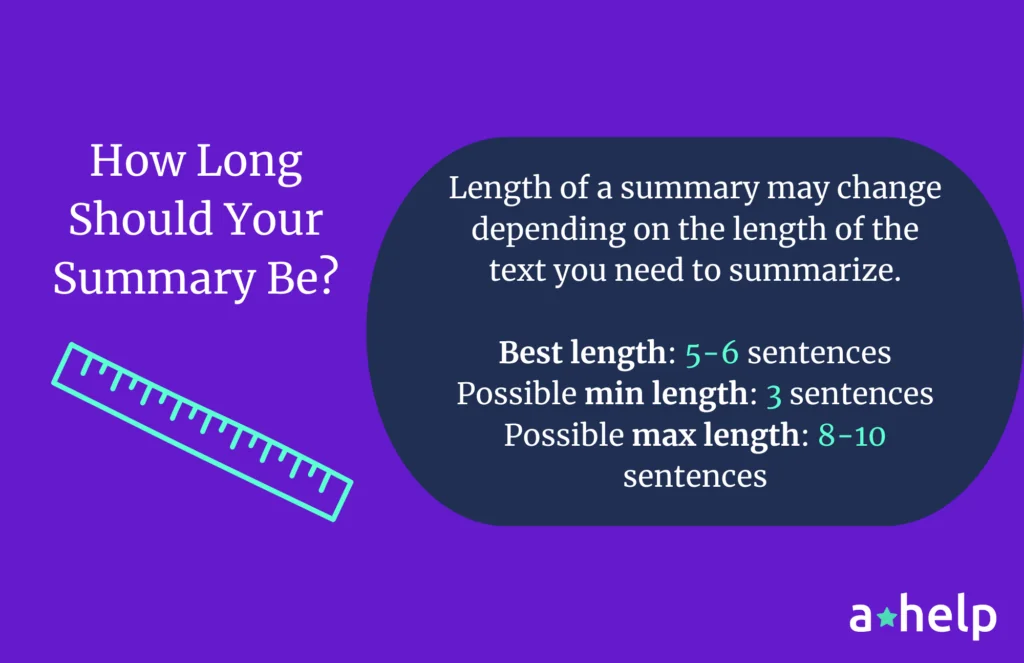Ever found yourself lost in a sea of text, trying to extract the essence without drowning in details? Summarizing is your lifeboat in this ocean of information. Whether you’re a student preparing for exams or simply trying to convey the gist of an article, knowing summary writing is highly needed. But how long should a summary be? Generally, a summary should be about one-third to one-fourth the length of the original text. So it can be somewhere from 3 to 6 sentences, and sometime seven 8-10. Let’s look a bit closer into the issue just to make sure your summary fits into the general standards.

✅ AI Essay Writer ✅ AI Detector ✅ Plagchecker ✅ Paraphraser
✅ Summarizer ✅ Citation Generator
What Is a Summary?
A summary is a concise and coherent version of a longer piece of text, such as an article, book, or lecture. Its primary goal is to provide a clear and direct overview of the original work’s main ideas and key points, allowing readers to quickly grasp its sense without delving into the details.
Key Characteristics of a Summary:
- Brevity
One of the most important features of a summary is its conciseness. It should be significantly shorter than the original text, typically about one-third to one-fourth of its length. This brevity makes the summary quick to read and easy to understand, therefore turning into an efficient tool for reviewing and recalling information. - Clarity
A summary should be clear and straightforward, using simple language and a direct writing style. It should avoid ambiguity and complexity, making sure that the reader can easily understand the main ideas and key points without any confusion. - Focus
The focus of a summary is on the central ideas and key points of the original text. It should exclude any extraneous details, examples, anecdotes, or personal opinions that do not directly contribute to the overall understanding of the text. - Accuracy
A summary must accurately reflect the content and intent of the original work. It should faithfully represent the author’s ideas and arguments, without distortion or misinterpretation. - Objectivity
Summaries should maintain a neutral tone and perspective, presenting the information without bias or subjective interpretation. This objectivity guarantees that the summary is a faithful representation of the original text.
Though quite short, summaries also have their unique structure. Usually, it includes the introduction, the body of the summary (meaning the main text), and the conclusion. We will discuss each of these parts further in our guide. Hopefully, you will be able to understand the summary writing process much better after this.
To learn more abour summarizing and run some test, explore the Summarizer by AHelp!
So, How Many Sentences Are There in a Summary?
As to the main question of the length of a summary, it can vary depending on the length and complexity of the original text.

However, as a general rule, a summary should be about one-third to one-fourth the length of the original. For shorter texts like articles or essays, a summary might be just a few sentences long, while for longer works like books or research papers, it could extend to a few paragraphs. The average number of sentences in a summary is not fixed, but it should be enough to convey the main points effectively without unnecessary detail. In general, though, the preferred length is somewhere around 5 to 8 sentences.
How to Write a Summary
Writing a summary is like creating a map of a vast landscape. It involves capturing the point of a text, and distilling its main ideas and key points into a more digestible form. The process requires careful reading, analysis, and the ability to condense information without losing its meaning.
Introduction
The first step in crafting a summary is to start with a clear and direct introduction. This should include the title of the original text and the name of the author. It’s like setting the stage for your readers, providing them with the necessary context to understand what’s to come. Alongside this, you should offer a brief overview of the main theme or argument presented in the text. Think of this as giving your reader a glimpse of the text’s core, the central message around which everything else revolves.
Main Body
Moving on to the main body of your summary, your task is to identify the main points of the text. Imagine you’re sifting through a treasure trove of ideas, picking out the most valuable gems. These points should be laid out in a logical order, mirroring the structure of the original text. This helps maintain the flow of ideas and makes your summary easier to follow.
As you translate these main points into your own words, it’s crucial to use paraphrasing rather than direct quotations. This not only shows your understanding of the material but also helps keep your summary concise. Your goal is to be as clear and succinct as possible, focusing solely on the vital information. This means leaving out any examples, anecdotes, or detailed explanations that don’t directly contribute to the overall understanding of the main ideas.
Additionally – Conclusion
While not always necessary, a summary may include a brief conclusion that wraps up the main points and provides a final overview of the text’s key ideas. This can help reinforce the summary’s main points and provide a clear endpoint for the reader.
Note that it is important to maintain the author’s perspective throughout your summary. This means staying true to their ideas and presenting them accurately. Your summary should be a reflection of the author’s work, seen through the lens of your understanding and expression.
What Is a Summary Question?
A summary question is a thought-provoking inquiry that arises from reading an article, often focusing on an intriguing point, moral, lesson, or feeling that isn’t explicitly addressed in the main body of the text. It serves as a reflective tool, prompting you to delve deeper into the content and explore its underlying themes or messages.
It is often used in academic settings to assess your understanding of reading and your ability to concisely convey its main ideas. When writing a summary in response to a summary question, it’s important to focus on the key points and arguments relevant to the question, so that your summary is targeted. The summary question should be addressed at the beginning of your summary-writing process, but only after you’ve read your source, to guide your selection of what to include and what to omit.
Conclusion
In summary (pun intended), the art of summary writing is all about finding the right balance between brevity and completeness. While there’s no one-size-fits-all answer to how many sentences a summary should be, aiming for about one-third to one-fourth the length of the original text is a good rule of thumb. By focusing on the main points, using clear and direct language, and responding effectively to summary questions, you can create summaries that are both informative and concise. So, next time you’re faced with a mountain of text, remember that with a little practice, you can distill it into a manageable and insightful summary.
FAQ
Follow us on Reddit for more insights and updates.





Comments (0)
Welcome to A*Help comments!
We’re all about debate and discussion at A*Help.
We value the diverse opinions of users, so you may find points of view that you don’t agree with. And that’s cool. However, there are certain things we’re not OK with: attempts to manipulate our data in any way, for example, or the posting of discriminative, offensive, hateful, or disparaging material.